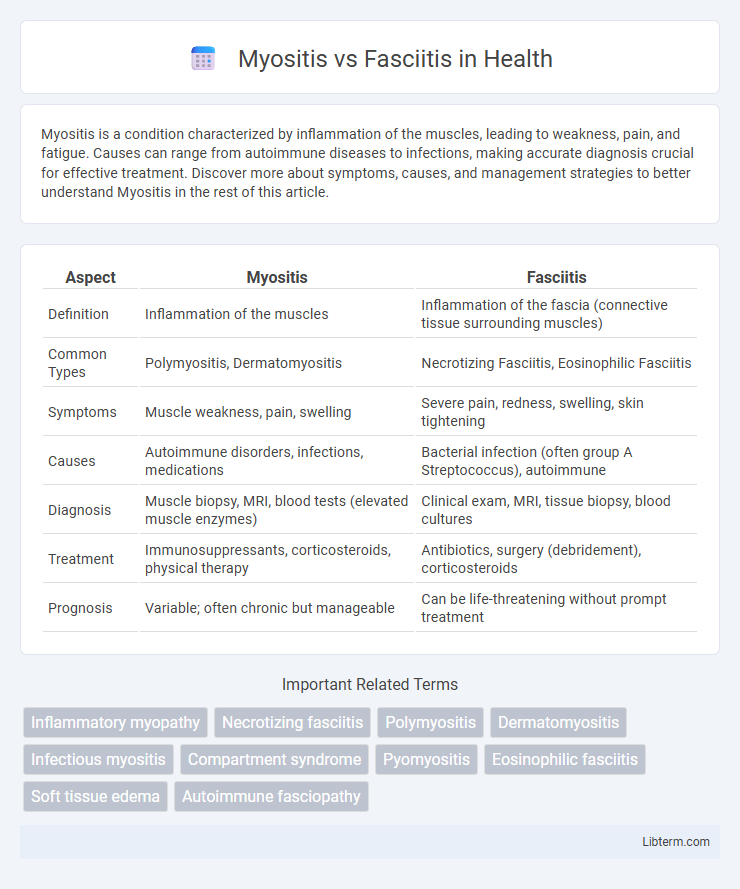Myositis is a condition characterized by inflammation of the muscles, leading to weakness, pain, and fatigue. Causes can range from autoimmune diseases to infections, making accurate diagnosis crucial for effective treatment. Discover more about symptoms, causes, and management strategies to better understand Myositis in the rest of this article.
Table of Comparison
| Aspect | Myositis | Fasciitis |
|---|---|---|
| Definition | Inflammation of the muscles | Inflammation of the fascia (connective tissue surrounding muscles) |
| Common Types | Polymyositis, Dermatomyositis | Necrotizing Fasciitis, Eosinophilic Fasciitis |
| Symptoms | Muscle weakness, pain, swelling | Severe pain, redness, swelling, skin tightening |
| Causes | Autoimmune disorders, infections, medications | Bacterial infection (often group A Streptococcus), autoimmune |
| Diagnosis | Muscle biopsy, MRI, blood tests (elevated muscle enzymes) | Clinical exam, MRI, tissue biopsy, blood cultures |
| Treatment | Immunosuppressants, corticosteroids, physical therapy | Antibiotics, surgery (debridement), corticosteroids |
| Prognosis | Variable; often chronic but manageable | Can be life-threatening without prompt treatment |
Introduction to Myositis and Fasciitis
Myositis is an inflammatory condition characterized by muscle swelling, weakness, and pain, often caused by autoimmune diseases, infections, or medications. Fasciitis involves inflammation of the fascia, the connective tissue surrounding muscles, commonly leading to severe tenderness and swelling, with conditions like necrotizing fasciitis representing a rapid, life-threatening infection. Differentiating myositis from fasciitis requires clinical evaluation, imaging techniques like MRI, and laboratory tests to identify specific markers of muscle or fascial inflammation.
Definitions: What is Myositis?
Myositis is an inflammatory muscle disease characterized by muscle weakness, swelling, and pain, often caused by autoimmune disorders, infections, or medications. It involves inflammation of skeletal muscles leading to muscle fiber damage and impaired muscle function. Diagnosed through muscle biopsy, blood tests for elevated creatine kinase, and MRI, myositis includes subtypes such as polymyositis, dermatomyositis, and inclusion body myositis.
Definitions: What is Fasciitis?
Fasciitis is the inflammation of the fascia, a thick band of connective tissue that surrounds muscles, blood vessels, and nerves. This condition often causes pain, swelling, and limited movement in the affected area, commonly seen in plantar fasciitis or necrotizing fasciitis. Unlike myositis, which involves inflammation of the muscle tissue itself, fasciitis specifically targets the fascia layer.
Causes and Risk Factors
Myositis is primarily caused by autoimmune disorders, infections, or drug reactions, leading to inflammation of the muscles, while fasciitis typically results from bacterial infections, trauma, or repetitive strain causing inflammation of the fascia surrounding muscles. Risk factors for myositis include genetic predisposition, certain viral or bacterial infections, and exposure to toxins, whereas fasciitis risk factors include diabetes, peripheral vascular disease, and immunosuppression. Both conditions involve inflammatory responses but differ significantly in their underlying causes and affected tissues.
Symptoms Comparison
Myositis presents with muscle weakness, pain, and swelling primarily affecting proximal muscles, while fasciitis typically causes localized pain, tenderness, and swelling over the fascia, often without significant muscle weakness. In inflammatory myositis, symptoms include difficulty climbing stairs or lifting objects, whereas fasciitis symptoms may involve skin redness and warmth due to inflammation of the connective tissue. Both conditions can involve tenderness, but myositis more significantly impacts muscle function, distinguishing it from fasciitis where fascial involvement predominates.
Diagnostic Methods
Myositis diagnosis primarily relies on elevated serum creatine kinase (CK) levels, electromyography (EMG), muscle biopsy, and magnetic resonance imaging (MRI) to detect muscle inflammation and fiber damage. Fasciitis diagnosis often involves clinical examination of swelling and pain, ultrasound imaging to identify fascial thickening, and MRI to visualize inflammation of the fascia surrounding muscles. Both conditions require integration of laboratory tests, imaging modalities, and histopathologic evaluation for accurate differentiation and treatment planning.
Treatment Approaches
Myositis treatment typically involves corticosteroids and immunosuppressive drugs to reduce muscle inflammation and prevent progression. Fasciitis, particularly necrotizing fasciitis, requires prompt surgical debridement alongside broad-spectrum antibiotics to manage infection and tissue damage. Physical therapy and pain management are common supportive treatments for both conditions to restore function and improve quality of life.
Prognosis and Complications
Myositis, characterized by inflammation of muscle tissue, often has a variable prognosis depending on the subtype, with idiopathic inflammatory myopathies potentially leading to chronic weakness and disability if not properly managed. Fasciitis, involving inflammation of the fascia, particularly in cases like necrotizing fasciitis, can progress rapidly and result in severe complications such as tissue necrosis, systemic infection, and increased mortality risk without prompt treatment. Early diagnosis and aggressive therapeutic intervention are critical in improving outcomes and minimizing long-term functional impairment in both conditions.
Prevention Strategies
Effective prevention strategies for myositis and fasciitis include maintaining proper hygiene to reduce infection risks, avoiding repetitive strain or trauma to muscles and fascia, and managing underlying autoimmune conditions through regular medical care. Implementing ergonomic practices and balanced physical activity helps minimize tissue inflammation and injury. Early diagnosis and treatment of infections and inflammatory disorders play a crucial role in preventing the progression or recurrence of both myositis and fasciitis.
Key Differences Between Myositis and Fasciitis
Myositis is an inflammatory condition primarily affecting the muscles, leading to muscle weakness and pain, whereas fasciitis involves inflammation of the fascia, the connective tissue surrounding muscles, causing localized pain and swelling. Myositis often presents with systemic symptoms and elevated muscle enzymes like creatine kinase, while fasciitis typically lacks systemic involvement and is diagnosed through clinical examination and imaging such as MRI. Treatment approaches differ as myositis may require immunosuppressive therapy, whereas fasciitis is often managed with anti-inflammatory medications and physical therapy.
Myositis Infographic

 libterm.com
libterm.com